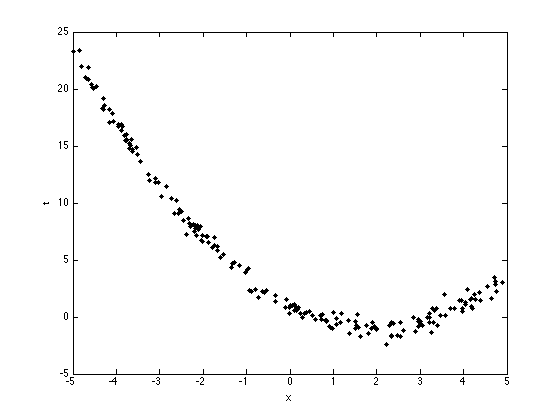Contents
synthquad.m
From A First Course in Machine Learning, Chapter 1. Simon Rogers, 31/10/11 [simon.rogers@glasgow.ac.uk]
clear all;close all;
Generate a synthetic dataset from a quadratic function
N = 200; %Number of data points % Generate random x values between -5 and 5 x = 10*(sort(rand(N,1))-0.5);
Define the function and the true parameters

w_0 = 1; w_1 = -2; w_2 = 0.5;
Define t
t = w_0 + w_1*x + w_2*(x.^2);
Add some noise
t = t + 0.5*randn(N,1);
Plot the data
figure(1); hold off plot(x,t,'k.','markersize',10); xlabel('x'); ylabel('t');

Fit the quadratic model and a linear model for comparison
Using vector matrix notation
X = []; for k = 0:2 X = [X x.^k]; if k == 1 linear_w = inv(X'*X)*X'*t; end if k == 2 quad_w = inv(X'*X)*X'*t; end end fprintf('\n Linear function: t = %g + %g x',linear_w(1),linear_w(2)); fprintf('\n Quadratic function: t = %g + %g x + %g x^2',... quad_w(1),quad_w(2),quad_w(3));
Linear function: t = 5.20924 + -2.08484 x Quadratic function: t = 0.989651 + -1.98841 x + 0.501596 x^2
Plot the functions
plotx = [-5:0.01:5]'; plotX = []; for k = 0:2 plotX = [plotX plotx.^k]; end figure(1);hold off; % Add the data again plot(x,t,'k.','markersize',10); xlabel('x'); ylabel('t'); hold on plot(plotx,plotX*quad_w,'r','linewidth',2); plot(plotx,plotX(:,1:2)*linear_w,'g','linewidth',2); legend('Data','Quadratic','Linear')
